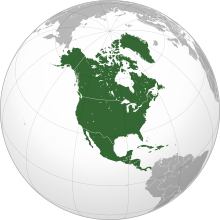
North America
Continent in the Northern Hemisphere / From Wikipedia, the free encyclopedia
Dear Wikiwand AI, let's keep it short by simply answering these key questions:
Can you list the top facts and stats about North America?
Summarize this article for a 10 years old
North America is a continent[lower-alpha 2] in the Northern and Western Hemispheres.[lower-alpha 3] North America is bordered to the north by the Arctic Ocean, to the east by the Atlantic Ocean, to the southeast by South America and the Caribbean Sea, and to the west and south by the Pacific Ocean. The region includes Canada, the Caribbean, Central America, Greenland, Mexico, and the United States.
 | |
| Area | 24,709,000 km2 (9,540,000 sq mi) (3rd) |
|---|---|
| Population | 592,296,233 (2021; 4th) |
| Population density | 25.7/km2 (66.4/sq mi) (2021)[lower-alpha 1] |
| GDP (PPP) | $30.61 trillion (2022 est.; 2nd)[1] |
| GDP (nominal) | $29.01 trillion (2022 est.; 2nd)[2] |
| GDP per capita | $57,410 (2022 est.; 2nd)[3] |
| Religions | |
| Demonym | North American |
| Countries | 23 sovereign states |
| Dependencies | 23 non-sovereign territories |
| Languages | English, Spanish, French, Dutch, Danish, indigenous languages, and many others |
| Time zones | UTC−10:00 to UTC±00:00 |
| Largest cities | List of urban areas:[5] |
| UN M49 code | 003 – North America019 – Americas001 – World |
.jpg/220px-Map_of_populous_North_America_(physical%2C_political%2C_population).jpg)
North America covers an area of about 24,709,000 square kilometers (9,540,000 square miles), representing approximately 16.5% of the Earth's land area and 4.8% of its total surface area. It is the third-largest continent by size after Asia and Africa, and the fourth-largest continent by population after Asia, Africa, and Europe. As of 2013[update], North America's population was estimated at nearly 579 million people in 23 independent states, or about 7.5% of the world's population. In human geography and in the English-speaking world outside the United States, particularly in Canada, the terms "North America" and "North American" are typically defined as including just Canada and the United States.[6][7][8][9][10]
The first human populations reached North America during the Last Glacial Period approximately 20,000 to 17,000 years ago, during which they crossed the Bering land bridge in the Bering Strait on their way to reaching North America. The Paleo-Indian period in North America followed the Last Glacial Period, and lasted until about 10,000 years ago when the Archaic period began. The classic stage followed the Archaic period, and lasted from approximately the 6th to 13th centuries. Beginning in 1000 AD, the Norse were the first Europeans to begin exploring and ultimately colonizing areas of North America.
In 1492, the exploratory voyages of Christopher Columbus led to a transatlantic exchange, including migrations of European settlers during the Age of Discovery and the early modern period. Present-day cultural and ethnic patterns reflect interactions between European colonists, indigenous peoples, African slaves, immigrants from Europe, Asia, and descendants of these respective groups.
Europe's colonization in North America led to most North Americans speaking European languages, including English, Spanish, and French, and the cultures of the region commonly reflect Western traditions. However, relatively small parts of North America in Canada, the United States, Mexico, and Central America have indigenous populations that continue adhering to their respective pre-European colonial cultural and linguistic traditions.